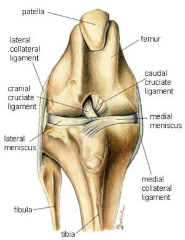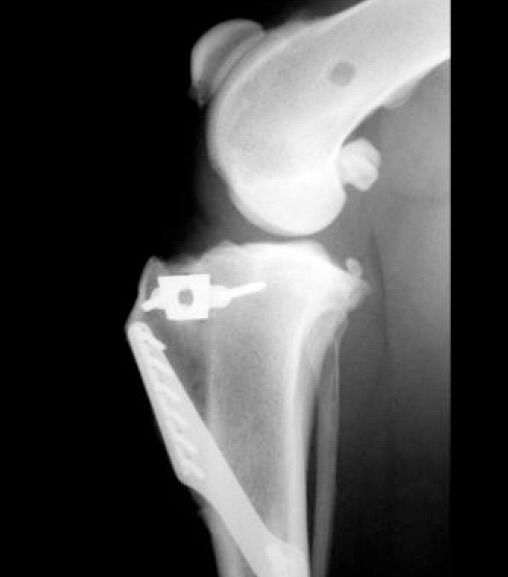Table of Contents
Summary | Knee Joint Diagram | Types | Symptoms | Treatment | Prevention
What You Need to Know:
Knee injuries are incredibly common for dogs of all ages to experience and they range from minor to necessitating surgery. As a responsible pet owner, you need to know how to care for them when these injuries crop up, and ideally how you can prevent them from occurring in the first place!
The dog knee joint is called a stifle joint. The joint has three bones (see diagram below), the femur, tibia and patella. The knee joint also contains the CCL (similar to human ACL), and a second ligament called the caudal cruciate ligament. The CCL and the caudal cruciate ligament form a cross shape. The joint also has a meniscus which acts as a shock absorber.
Many dog knee injuries happen when there is an injury, joint disease or when the CCL ruptures, making it difficult for the dog to walk. When a rupture occurs the femur moves backwards on the tibia. Your veterinarian may refer to this as a cranial tibial subluxation. This injury also causes pain for the dog. While most human ACL problems occur suddenly during exercise or sports, a dog CCL problem is a chronic condition that worsens over time vs. occurring suddenly. Think of the CCL as the strands of a rope that fray over time. When too much wear occurs, surgery is required to replace the broken CCL or change the way the stifle works, so that the CCL ligament is not needed.
CCL injuries almost always are accompanied by arthritis, which is not reversible. For some injuries, having your dog wear a brace could bring some relief.
The Stifle (Knee) Joint
First an anatomy lesson. These are the different bones and ligaments that make up the canine stifle, colloquially known as the knee.

Types of Dog Knee Injuries
The knee is a complex joint where bone, muscle, and ligament comes together. With all the moving pieces and uses, there are plenty of ways the stifle can be injured. The three most common are:
- Patellar Luxation – The patella is a small bone that sits in a groove on the femur, making a knee cap. The patella helps the knee flex and extend as it should. Luxation is when the patella slips out of the groove. Typically this is a natural occurrence because sometimes the groove is shallow or the muscles around it are misaligned.
- Osteochondritis Dissecans – A painful joint disease, osteochondritis dissecans is a condition in which abnormal cartilage grows at the end of bones, creating ‘flaps.’ The cartilage will crack with activity. Osteochondritis dissecans is more common in young, growing medium and large breed dogs.
- Cranial Cruciate Ligament Rupture (CCL) – The cranial cruciate ligament is analogous to the ACL in humans. This injury may be familiar to anyone who has injured their knee in sports. When the ligament is torn or ruptured, the stifle is no longer stabilized as it should be and can be incredibly painful (and uncomfortable) for dogs to walk on.
Symptoms of Knee Injuries
Unfortunately for us, our dogs can’t simply tell us when they’ve hurt their knee, so we need to be vigilant and recognize the signs.
- Sitting strangely, to take the weight off their knees
- Stiffness in their legs
- Swelling in the joint
- Clicking
- And of course, lameness
Other Common Causes of Lameness
Before we dive too deep on knee injuries, it’s important to know that lameness can be caused by a range of different injuries, minor or major. Before rushing to the vet and discussing surgery, take a look at your pup to identify if it’s not caused by something else.
Minor Causes of Lameness
Any of these could happen to your pooch and cause them to limp around the house a bit, and vet attention might not be immediately necessary.
- Sprain or strain in their leg: sprains and strains are difficult to identify with the naked eye. Let your dog rest, keep them from putting weight on it, and see if that helps.
- Cut on paw or foot: a cut on the pad of their paw will keep them from wanting to put any weight on the foot. Give some basic first aid to keep the wound from getting infected and let your dog rest. If it is particularly deep or won’t stop bleeding, then get your pet to the vet!
- A foreign object stuck in paw or foot: foreign objects can be small and easily managed (think a thorn or burr stuck in the paw) to something needing professional care (something broken off under the skin). Get your pet into a relaxed place and investigate what’s bothering them.
- Torn or broken nail: Nail breaks are a prevalent injury for dogs, and they can be either minor or more serious. If the nail won’t stop bleeding after you tend to it, get to the vet and have them take a look at it. In minor cases, your dog instinctively knows how to care for the wound, licking at it to keep it clean as it heals (just be sure not to let it turn into a hotspot.)
If none of these apply, then you have either a knee injury or another serious reason for lameness, which will need vet attention.
Treatment
Surgery
Depending on the severity of the injury (or malformation of the joint), surgery may be the only option to get your pet back on track. A complete CCL (cranial cruciate ligament) tear will need surgery to reattach the ligament. A CCL is the same as structure as the ACL in humans, but in dog's it is called a CCL. Veterinarians can use a laser to deepen the groove for the patella. Speak with your vet if surgery is necessary or if proactive care can prevent it.
There are newer procedures available called TPLO (tibial plateau leveling Osteotomy) and TTA (tibial tuberosity advancement). Both procedures cut the tibia bone and use a bone plate to hold the cut bone in position.

Source: Solutions for your Dog's Knee Injury, Dr. David Leahy
Use a Brace
Many people are experiencing great results when supporting their dog with a dog knee brace. There is a range of styles out there from hard framed, custom-built braces to soft, standardized supportive braces. No matter their manufacture, these work in the same way, helping to keep the stifle joint stabilized so that the leg can function normally. In keeping the joint stabilized, it also does double duty, helping to prevent the ligaments in the knee from further injury. Depending on the severity of the CCL tear, a brace can help prevent your dog from needing surgery.
How to Support and Prevent Dog Knee Injuries
Know Your Dog's Risk Factors
Age, breed, health, and activity levels are all important to consider in keeping your dog healthy. While some conditions (like osteochondritis dissecans) are more prone to young and developing dogs, others can afflict older canines more frequently. CCL ruptures can affect any dog but are much more likely to occur in older, overweight animals. We can’t change our dog’s breed or age, so we have to be proactive about the other risk factors.
Healthy Diet and Exercise
As mentioned previously, weight can be a considerable risk factor for your pooch. Feed them the correct diet. Use the Merck Vet Manual to understand the nutritional requirements of your dog better. Is your dog already overweight? Follow Dog Health Guide’s Diet for an Overweight Dog.
Many dogs benefit from joint supplements that contain methylsulfonylmethane, chondroitin, and glucosamine.
A proper diet is only one step. Keep your dog active, with age-appropriate exercise. Many injuries happen when an older dog gets enthusiastic about jumping on the couch or wears themselves out at the dog park. Dog’s just want to have fun, and it’s up to you to make sure it’s fun they are capable of enjoying safely.
For Additional Reading
Plain English explanation of the way the dog knee joint works and dog knee surgery.
